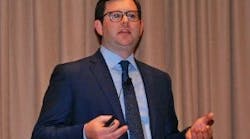“From a labor-market standpoint, it’s how technology is driving the speed of change. The idea that we have a job for life is gone.” ManpowerGroup’s Chris Layden discussed labor-market trends affecting industrial companies at the Workforce Development Forum at this week’s Automation Fair in Philadelphia.
The need to hire and keep talent remains a top concern for industrial companies. It’s an eternal struggle and one that has exploded as workers retire and the next generation shies away from manufacturing jobs.“Eighty-seven percent of employers indicate they’re going to need to increase or maintain their need for talent,” said Chris Layden, vice president at ManpowerGroup, who shared his organization’s insights and survey results during the Workforce Development Forum at this week’s Automation Fair in Philadelphia. “We’re also seeing that functions with routine tasks are being automated. That’s important in terms of how we’re going to prepare the workforce. We’re looking for people with lifelong learning.”
According to the survey, 10% of employers expect to reduce their workforce as a result of automation. However, 65% of companies are planning to increase IT jobs. Digitalization’s biggest impact will be in manufacturing. “Global talent shortages—the skills gap, the war for talent— are at a 12-year high. Forty-five percent of employers are having trouble finding talent,” said Layden, whose company provides training and development to bridge the skills gap and prepare the workforce.
“We have 70 years of global workforce solutions expertise,” explained Layden. “Our insight comes from research. We help people to gain new skills. We do that all over the world. We have 30,000 people around the world. We are the largest employer in most of the 80 countries we service.”
Labor market dynamics
The four macro workforce trends that ManpowerGroup has identified are the technological revolution, the rise of client sophistication, greater individual choice and shifting demographics.
“There are structural changes,” explained Layden. “From a labor-market standpoint, it’s how technology is driving the speed of change. The idea that we have a job for life is gone. Employers have to think differently about training and impact. Regarding demographics, nearly a quarter of our boomers are going to be retiring.”
Layden also identified the top 10 most in-demand roles globally, with skilled trades, engineers and technicians occupying the top three slots. “Fifty thousand technician roles are open at any given time,” said Layden. “It’s the need not just for a technician with the right hard skills, but the right human strengths.”
How are employers addressing talent shortages? Fifty-four percent are providing additional training and development, and 36% of employers are adjusting the education and experience required to fill roles. “Employers are going to need to take a more aggressive approach to what is required to hire,” explained Layden. “This will continue to be an area of growth. The four solutions to talent shortages are to invest in learning and development, to go to market to attract the talent that cannot be built in-house, to cultivate communities of talent beyond the organization and to help people to move on or move up to new roles inside or outside the organization.”
Benchmarking best practices
Rockwell Automation is seeing much the same trends that ManpowerGroup’s survey indicates. “We see the aging workforce, the skills gap and technology,” said Scott Lapcewich, vice president and general manager, customer support and maintenance, Rockwell Automation. “I’m hearing a lot about the convergence of IT and OT—being able to connect assets on the plant floor to higher-level systems. The low cost of data storage can positively impact manufacturing, too. Manufacturing will change over the next decade. The manufacturing team in your company will look different in the future.”
Rockwell Automation went through its own digital transformation more than five years ago. “Leadership needs to recognize, adapt and leverage technology,” said Lapcewich. “Beyond just leadership, there needs to be a management commitment. Culturally, you’re moving toward an environment that’s constant learning.”
The response at Rockwell Automation, as it looked at its own operations, was to compare against the best. “Who are the leaders in digitalization, automation and software? And how do we get there ourselves?” asked Lapcewich. “It’s going to drive faster decision-making on how to adjust supply chain. It’s a big cultural change. You’re going to want people on your teams who can bring fresh ideas. What can this enable us to do and think differently?”
Key jobs for advanced manufacturing in the factory of the future are technicians, analytics and data scientists. “About 30% of the work tasks of the current manufacturing workforce can be automated,” said Layden. “It’s going to drive a change in the types of skills that will be needed. Rockwell supports three pillars of workforce development: lifelong learning, competency-based instruction for current needs and partnerships between learning centers and manufacturers. We need to get out there and encourage and fund interest in the ‘STEM’ fields of science, technology, engineering and math. And we need to bring together manufacturers with local governments and educational institutions.”
The partnership between Rockwell Automation and ManpowerGroup has been growing since the two organizations launched the Academy of Advanced Manufacturing (AAM) in August 2017.
Veteran resources
Four classes of U.S. military veterans ran through the program in 2018. “We graduated the fourth class in Mayfield, Ohio, this past Thursday, which makes almost 100 graduates now,” said Joe Allie, director, global competency, Rockwell Automation, who heads up the program.
“It costs money to train people,” explained Allie. “It costs money to bring people into an organization. Talent is hard to find. There’s a skills mismatch. And it’s going to get worse. More than three-quarters of employers say new skills will be required over the next two years, and they don’t even know what those are. It costs money to source, recruit, assess and train. And the people on your team who are training those folks are losing productivity. If you take all of those things into account, one of the solutions that ManpowerGroup and Rockwell Automation came up with was AAM.”
About 175,000 veterans leave the military each year, said Allie. “One-seventh of those folks perform technical jobs in the military, which creates a pool of talented, skilled, disciplined and underutilized resources,” he explained. “We know where we can find a pool of people who can help us, and we want to be sure the job we’re going to train them for is the right job.”
AAM’s goal is to train 1,000 veterans annually for high-tech roles in advanced manufacturing by 2021. Advanced certification programs are available in drives, motion, software and instrumentation/process, with a mechatronics program in development. Seven classes are scheduled for 2019, with graduates available in April, May, July, August, September, October and November.
“We don’t only do the technical part,” said Allie. “We spend almost one-third of the 12 weeks working on activities that are required to be successful in a corporate environment. The technical training is the coolest part. But the professional training is the most important part.”
The editors of Control are on-site at Automation Fair 2018 to bring you breaking news, innovations and insights from the event. Once the event is over, they will put together a report featuring the top news. Pre-order your copy today.






